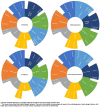Chatbot use cases in the Covid-19 public health response
- PMID: 35137107
- PMCID: PMC8903403
- DOI: 10.1093/jamia/ocac014
Chatbot use cases in the Covid-19 public health response
Abstract
Objective: To identify chatbot use cases deployed for public health response activities during the Covid-19 pandemic.
Material and methods: We searched PubMed/MEDLINE, Web of Knowledge, and Google Scholar in October 2020 and performed a follow-up search in July 2021. We screened articles based on their abstracts and keywords in their text, reviewed potentially relevant articles, and screened their references to (a) assess whether the article met inclusion criteria and (b) identify additional articles. Chatbots, their use cases, and chatbot design characteristics were extracted from the articles and information from other sources and by accessing those chatbots that were publicly accessible.
Results: Our search returned 3334 articles, 61 articles met our inclusion criteria, and 61 chatbots deployed in 30 countries were identified. We categorized chatbots based on their public health response use case(s) and design. Six categories of public health response use cases emerged comprising 15 distinct use cases: risk assessment, information dissemination, surveillance, post-Covid eligibility screening, distributed coordination, and vaccine scheduler. Design-wise, chatbots were relatively simple, implemented using decision-tree structures and predetermined response options, and focused on a narrow set of simple tasks, presumably due to need for quick deployment.
Conclusion: Chatbots' scalability, wide accessibility, ease of use, and fast information dissemination provide complementary functionality that augments public health workers in public health response activities, addressing capacity constraints, social distancing requirements, and misinformation. Additional use cases, more sophisticated chatbot designs, and opportunities for synergies in chatbot development should be explored.
Keywords: Covid-19; chatbot; conversational agents; pandemic; public health response.
© The Author(s) 2022. Published by Oxford University Press on behalf of the American Medical Informatics Association. All rights reserved. For permissions, please email: journals.permissions@oup.com.
Figures
References
-
- Gray M. WHO reverses position on face masks as coronavirus cases climb. New York Post. June 6, 2020
-
- Eaton M, King AB, Dalmayne E, Seigler A. Trump suggested ‘injecting’ disinfectant to cure coronavirus? We’re not surprised. New York Times. 2020.
-
- Kalter L. Medical Helpline Calls Soar as COVID-19 Spreads. April 1, 2020. https://www.webmd.com/lung/news/20200401/medical-helpline-calls-soar-as-.... Accessed August 20, 2020.
-
- Diederich S, Brendel AB, Morana S, Kolbe L. On the design of and interaction with conversational agents: An organizing and assessing review of human-computer interaction research. J Assoc Inf Syst 2022; 23 (1): 96–138.
MeSH terms
LinkOut - more resources
Full Text Sources
Medical
Miscellaneous




